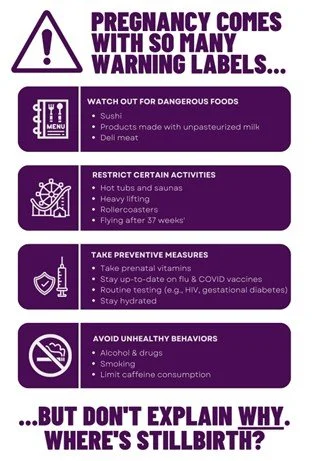Honoring Autumn: Preventing Future Stillbirths in the US
By: Debbie Haine Vijayvergiya
12 years ago today— life as I knew it changed forever the moment I birthed my lifeless baby girl, Autumn Joy. As I struggled to make sense of the senseless, I promised her that her life would not be lost in vain. It was then I vowed that I would do whatever I could to protect others from experiencing the horrors of bringing a stillborn baby into this world.
Despite my best efforts to sound the alarm on the US stillbirth crisis, more than 550,000 parents have endured the same devastating, life-altering pain in the time since Autum was born. That’s 550,000 parents who anticipated the birth of their child, only to grieve their death. 550,000 parents who celebrated their pregnancies with family and friends, assembled cribs, installed car seats, spent months anxiously and excitedly awaiting the arrival of their baby, only to leave the hospital with a small box of mementos and a pamphlet on grief.
Every year more than 40,000 US parents face the tragic reality of stillbirth – or the death of an expected child after 20 weeks’ gestation. I never knew what stillbirth was or that I was at risk, until it happened to me.
The stigma surrounding stillbirth is both harmful to families experiencing loss and hinders public health efforts to prevent future tragedies. Many families are led to believe that they will bring home a healthy baby once they have cleared the first trimester, but the harsh reality is that this is not true. Most are well aware of the realities of miscarriage, but stillbirth is rarely discussed. The laundry list of dos and don’ts that families receive during pregnancy rarely mentions stillbirth. These warnings tell expectant parents what to do to “protect their baby,” but never explain what they are protecting them from—stillbirth is left out of these messages. We must stop forcing parents to fill in the blanks, and instead empower them with the information that they need to better understand the risks and realities of stillbirth.
As we think about what’s possible when it comes to stillbirth prevention, let’s consider the model set forth by the airlines, with an untold number of safety controls behind-the-scenes, but who also insist on passenger education at the beginning of every single flight. Anyone who has flown knows that their “seat cushion can be used as a flotation device in the unlikely event of a water landing,” along with countless additional tips to keep travelers safe. The scary truth is that our pregnancies aren’t receiving anywhere near the same level of concern. Pregnant people are rarely educated about stillbirth, let alone the warning signs that something could be wrong with their baby.
While healthcare providers have their own set of safety controls such as blood pressure checks, glucose screening tests, and ultrasound imaging, they only go so far. None of these measures empower expectant parents with the knowledge of the risks and realities of stillbirth and fail to equip them with invaluable knowledge that could save their expected child’s life.
If we take the metaphor of the airplane one step further, the number of stillbirths that occur in the US each year is equivalent to two Boeing 737’s, each with a maximum capacity of 188 passengers, crashing every week for an entire year. It is impossible to imagine a world in which planes were literally falling from the sky on a weekly basis, with everyone standing by watching it happen.
And yet, it feels as though this is exactly what is happening with stillbirth in the United States. Thousands of babies die each year, and there seems to be little urgency to prevent these tragic and often preventable deaths.
However, hope is not lost as I am working tirelessly to get the bipartisan SHINE for Autumn Act reintroduced and passed in the 118th Congress. SHINE will focus on preventing stillbirths through enhanced data collection, research, education, and awareness. This bill is vitally important to the well-being of this county as it would authorize funding to put us on a path to keep these metaphorical planes in the skies, and to send more families home from the hospital with their babies safe in their arms.
In March 2023, the Stillbirth Working Group of the Eunice Kennedy Shriver National Institute of Child Health and Human Development released a Congressionally-mandated report calling for improved efforts around the quality of data collected, more research, and increased awareness and education – the exact elements that the bipartisan SHINE for Autumn Act would address. These efforts would put us on a path to begin tracking the US stillbirth crisis and identifying opportunities to prevent future deaths
The stillbirth rate is a critical measure of a populations’ health, according to public health experts. If that’s the case, what does this say about the well-being of our nation? To learn how you can join our efforts to get the bipartisan SHINE for Autumn Act passed this Congress, please visit www.shineforautumnact.org.
Debbie Haine Vijayvergiya’s daughter, Autumn Joy, was born still in July 2011. Since then, Debbie has become a powerful advocate at the state and national levels, working tirelessly to improve stillbirth outcomes and to raise stillbirth awareness. In 2013, Debbie assisted in drafting New Jersey’s first-ever stillbirth legislation and in June 2014, Governor Chris Christie signed The Autumn Joy Stillbirth Research and Dignity Act into law. Later in 2014, Debbie founded The 2 Degrees Foundation, an organization dedicated to giving every family in the state of New Jersey a fighting chance against stillbirth. More recently, she has worked with Members of Congress and their staff to advance the federal stillbirth legislation, named for her daughter. Debbie resides in New Jersey with her husband and two children.

